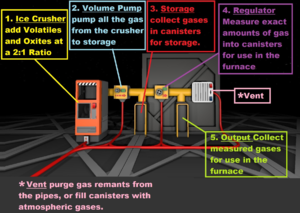Fuel
From Unofficial Stationeers Wiki
Revision as of 22:04, 4 August 2024 by Starviking (talk | contribs) (Added a section on collecting gases and using the ice crusher to collect gases and mix fuel)
|
| |
| Specific heat | 20.86 Joule / mol |
|---|---|
Contents
Description
There are two types of fuel, solid fuel and gas mixtures. The only solid fuel available in the game right now is Coal, coal can be used to fuel the Solid Fuel Generator.
In order to use gasses for fuel you need a combustible gas combined with an oxygen source. The only flammable gas in the game is Volatiles (labeled as H2), the two oxygen sources are Oxygen (2:1 mix simply called fuel) and Nitrous Oxide (1:1 mix called superfuel or NOS).
Using Fuels
Fuel Combustion
Autoignition Temperature: 300℃
2 Volatiles + 1 O2 -> 3 Pollutant + 6 CO2 + 572kJ
Fuel Combustion Using a H2 Combustor
2 Volatiles + 1 O2 -> 2 H2O + 429kJ
Superfuel Combustion
Autoignition Temperature: 50℃
1 Volatiles + 1 N2O -> 2 N2 + 2 CO2 + 572kJ
Note that staying below autoignition temperature means condensation for Nitrous Oxide at more than about 1MPa pressure, making it hard to store the fuel mix in large quantities without liquid management. While this reaction releases the same amount of energy as the classic fuel combustion above, it does so using half the volatiles and heating waste gases with less thermal mass resulting in higher temperatures.
Collecting gases
Gases can be collected from a number for sources. On some planets Oxygen may be collected directly from the atmosphere. This can be accomplished with an active vent, some pipe and a gas tank storage. On other planets the oxygen will have to be filtered out from the other gases. A filtration unit and a filter will be needed for this. Some planets, however, have no atmosphere at all. In these cases the gases needed can be obtained by melting or crushing ices. This is by far the most common source for gases early in the game. A basic Ice Crusher setup will provide most of your gas collection and mixing needs.
Basic Ice Crusher Setup
- 1 x Ice Crusher
- 5 x Pipes
- 1 x Volume Pump
- 1 x Pressure Regulator
Optional
- 1 x Active Vent
With this setup you can collect gases from ices to mix later. You can also pre-mix the gases by adding Volatile ice and Oxite at a 2:1 ratio. You can then load the pre-mixed fuel in canisters in pre-measured amounts using the pressure regulator.
Mixing Fuel
You can easily mix fuel by adding O2 and H2 to a pipe network in order to put it into canisters or pump into a furnace.
H2 can be attained by melting the Ice (Volatiles) that can be found in some worlds while being part of the atmosphere of Vulcan. O2 can be attained by melting the Ice (Oxite) or again from some atmospheres. N2O is part of Ice (Nitrice) or can be created by the Nitrolyzer.
Depending on how exact the proportions of your gas mixture are you will end up with different end temperatures and pressures after ignition.
Basic Canister Mixing Setup
Parts required
- 2 x Portables Connector
- 2 x Portable Gas Tank
- 1 x Pipe Gas Mixer
- 1 x Gas Tank Storage
- n x Pipes
- n x Cables
- n x Gas Canister
Setup
- Place both Portable Connectors
- Connect both Portable Connectors to the the inputs of the Pipe Gas Mixer
- Connect the Pipe Gas Mixer output to the Gas Tank Storage input
- Connect the Pipe Gas Mixer power input to power source.
Use
- Put first Portable Gas Tank or scrubber filled with O2 on one Portables Connector.
- Put second Portable Gas Tank or scrubber filled with H2/volatile on the other Portables Connector.
- Use a wrench to connect both Portable Gas Tanks to their places.
- Optional: for a perfect fuel mix, ensure the temperatures of both gases are exactly the same.
- Set the Pipe Gas Mixer to desired combination (34% O2 + 66% H2) Note: as the combination is a floating point number, you can also enter 0.333... or 0.666... with a labeler to get a more precise mix.
- Turn on Pipe Gas Mixer
- Place an empty Gas Canister in Gas Tank Storage.
| Gases and Liquids
| |||
|---|---|---|---|
| Elements | Compounds | Mixtures | Other |
|
|
|||

